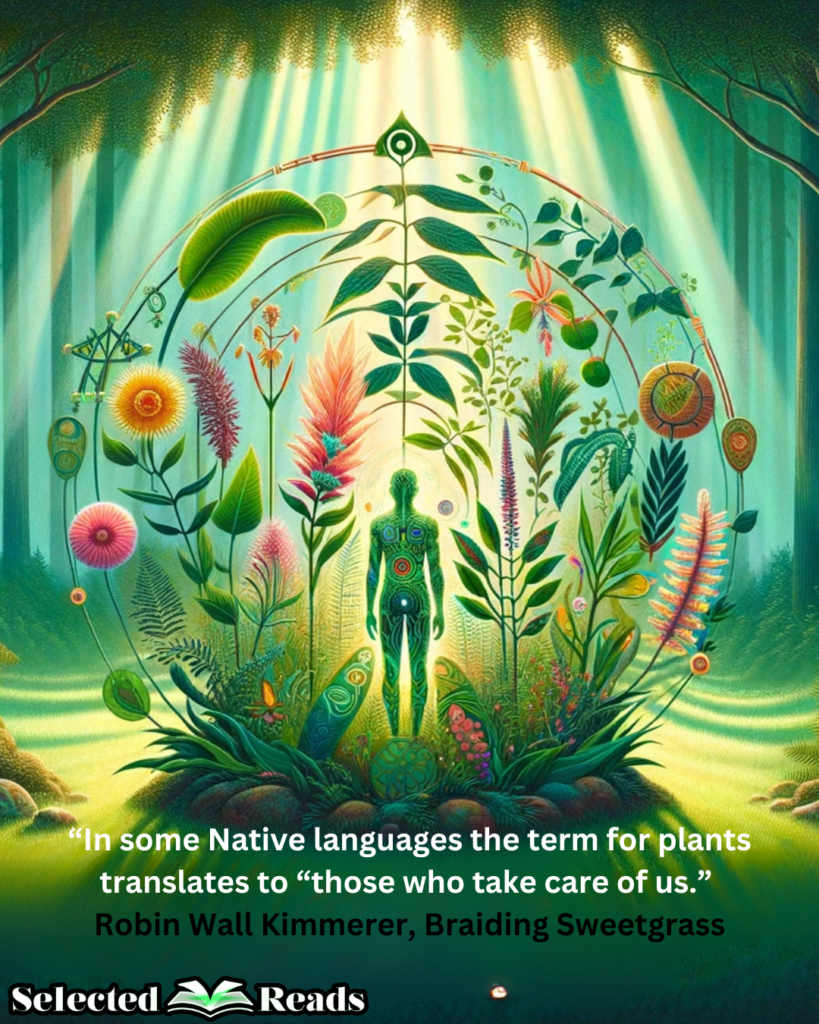Today’s book , “Braiding Sweetgrass,” by Robin Wall Kimmerer, takes you through the entwining paths of indigenous wisdom, scientific knowledge, and the profound teachings of plants. This book is an invitation to view the natural world through a lens that harmonizes ancient traditions with modern scientific thought.
In this post, we’ll first delve into an extended summary of “Braiding Sweetgrass.” This summary aims to encapsulate the essence of Kimmerer’s narrative, weaving through the key themes and insights that make this book a compelling read.
Following the summary, we’ll explore some poignant quotes from the book. Kimmerer’s language is not just informative but also deeply poetic, and her words have the power to resonate on multiple levels. These selected quotes are intended to give you a taste of her eloquent writing style and the profound messages embedded in her work.
Finally, for those who love to engage with literature in a more interactive and communal way, we’ve compiled a list of thought-provoking book club questions. These questions touch on the themes of ecological awareness, the integration of knowledge systems, and the personal reflections that “Braiding Sweetgrass” inspires.
Braiding Sweetgrass Summary
“Braiding Sweetgrass: Indigenous Wisdom, Scientific Knowledge, and the Teachings of Plants” by Robin Wall Kimmerer is a remarkable book that weaves together different ways of understanding and relating to the natural world. Kimmerer, a botanist and a member of the Citizen Potawatomi Nation, offers a unique perspective that blends scientific knowledge with indigenous wisdom, particularly focusing on the lessons we can learn from plants and the natural environment.
The book is structured as a series of essays, each drawing on Kimmerer’s experiences as an indigenous scientist, a mother, and a teacher. These narratives are deeply personal yet universally resonant, exploring themes such as gratitude, reciprocity, and the importance of storytelling in understanding our place in the world.
One of the central themes of “Braiding Sweetgrass” is the idea of reciprocity with the natural world. Kimmerer challenges the reader to consider not just what we can take from nature, but what we can give back. She emphasizes the importance of gratitude and respect for the gifts that plants and animals provide us, advocating for a relationship with nature that is based on mutual benefit and harmony, rather than exploitation.
Kimmerer also delves into the concept of ecological consciousness, arguing that a deeper understanding and appreciation of our interconnectedness with nature is essential for the health of our planet. She discusses how indigenous teachings can contribute to this consciousness, offering insights into sustainable living and environmental stewardship.
Throughout the book, Kimmerer shares stories from indigenous cultures, particularly those of her Potawatomi ancestors, to illustrate how traditional ecological knowledge can offer valuable lessons for contemporary environmental issues. She contrasts these indigenous perspectives with Western scientific approaches, highlighting how the integration of these viewpoints can lead to a more holistic understanding of ecology.
The narrative is enriched with descriptions of various plants and natural phenomena, from the way goldenrod and asters complement each other in the wild, to the life cycle of salamanders and the growth of sweetgrass. These stories are not just biological observations but are imbued with deeper meanings and teachings about life and our relationship with the Earth.
“Braiding Sweetgrass” is more than just a book about plants or science; it’s a call to action for environmental responsibility and a plea for a renewed relationship with the natural world. Kimmerer invites readers to listen to the voices of the non-human world and to consider the ways in which we can live more harmoniously with nature. Her writing is both poetic and accessible, making complex concepts understandable and deeply moving.
Braiding Sweetgrass Quotes
Here are some stand-out quotes from Braiding Sweetgrass:
“In some Native languages the term for plants translates to “those who take care of us.” ― Robin Wall Kimmerer, Braiding Sweetgrass
“Action on behalf of life transforms. Because the relationship between self and the world is reciprocal, it is not a question of first getting enlightened or saved and then acting. As we work to heal the earth, the earth heals us.” ― Robin Wall Kimmerer, Braiding Sweetgrass
“To be native to a place we must learn to speak its language.” ― Robin Wall Kimmerer, Braiding Sweetgrass
“This is really why I made my daughters learn to garden—so they would always have a mother to love them, long after I am gone.” ― Robin Wall Kimmerer, Braiding Sweetgrass
“To love a place is not enough. We must find ways to heal it.” ― Robin Wall Kimmerer, Braiding Sweetgrass
“Our indigenous herbalists say to pay attention when plants come to you; they’re bringing you something you need to learn.” ― Robin Wall Kimmerer, Braiding Sweetgrass
“Joanna Macy writes that until we can grieve for our planet we cannot love it—grieving is a sign of spiritual health. But it is not enough to weep for our lost landscapes; we have to put our hands in the earth to make ourselves whole again” ― Robin Wall Kimmerer, Braiding Sweetgrass
“Paying attention is a form of reciprocity with the living world, receiving the gifts with open eyes and open heart.” ― Robin Wall Kimmerer, Braiding Sweetgrass
“Knowing that you love the earth changes you, activates you to defend and protect and celebrate. But when you feel that the earth loves you in return, that feeling transforms the relationship from a one-way street into a sacred bond.” ― Robin Wall Kimmerer, Braiding Sweetgrass
“The trees act not as individuals, but somehow as a collective. Exactly how they do this, we don’t yet know. But what we see is the power of unity. What happens to one happens to us all. We can starve together or feast together.” ― Robin Wall Kimmerer, Braiding Sweetgrass
Braiding Sweetgrass Book Club Questions
“Braiding Sweetgrass: Indigenous Wisdom, Scientific Knowledge, and the Teachings of Plants” by Robin Wall Kimmerer is a thought-provoking book that offers a wealth of topics for discussion. Here are some engaging book club questions to consider:
- Integration of Knowledge: How does Kimmerer blend indigenous wisdom with scientific knowledge? Discuss examples where you found this integration particularly effective or enlightening.
- Concept of Reciprocity: Reciprocity with nature is a central theme in the book. How does this idea challenge or complement your own views on the human relationship with the natural world?
- Personal Reflections: Were there any personal stories or reflections shared by Kimmerer that particularly resonated with you? Why do you think they had an impact?
- Lessons from Plants: Kimmerer discusses various plants and their significance. Which plant story was most compelling for you, and what did you learn from it?
- Cultural Perspectives: How does the book broaden your understanding of indigenous perspectives on nature and the environment? Were there any insights that were particularly new or surprising to you?
- Environmental Stewardship: In what ways does the book inspire you to think about environmental stewardship? Did it change your thoughts on how you personally relate to the environment?
- Role of Storytelling: Kimmerer uses storytelling as a way to convey knowledge and wisdom. How does this approach affect your reading experience and understanding of the book’s themes?
- Ecological Consciousness: Discuss the concept of ecological consciousness as presented in the book. How does this idea manifest in your own life, or how could it?
- Gratitude and Giving Back: The book emphasizes gratitude and giving back to nature. How can these concepts be incorporated into modern life, which is often disconnected from natural processes?
- Favorite Quotes: Share a quote from the book that struck you as particularly powerful. Why did this quote stand out to you?
- Comparisons to Other Works: How does “Braiding Sweetgrass” compare to other books you’ve read on similar topics, whether they’re about botany, indigenous cultures, or environmentalism?
- Applying the Lessons: What are some practical ways you can apply the lessons from “Braiding Sweetgrass” in your own life or community?
Final thoughts
In conclusion, “Braiding Sweetgrass” by Robin Wall Kimmerer is a profound and beautifully written work that offers a unique and necessary perspective on our relationship with the natural world. Through a blend of indigenous wisdom, personal narrative, and scientific inquiry, Kimmerer invites us into a deeper understanding of the world around us and our place within it. The book is a call to recognize the gifts of the earth, to learn the languages of other beings, and to engage in a reciprocal relationship with the natural world.











